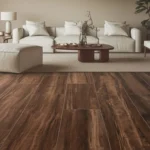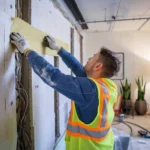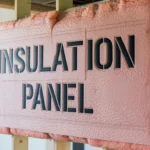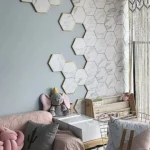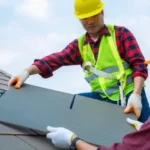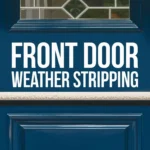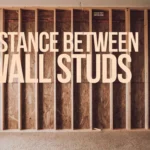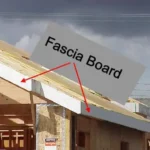
Content
Have you ever noticed how your energy bills spike every winter, no matter how much you adjust the thermostat? If you’re a Vaughan homeowner, you’re battling Ontario’s brutal temperature swings that can stress any home’s insulation system.
Spray foam insulation solves this problem by creating an unbroken seal around your home’s most vulnerable spots. While traditional insulation leaves gaps that let cold air sneak in during winter and cool air escape during summer, spray foam expands to fill every crack and corner. The result? Your home maintains comfortable temperatures even when Ontario weather hits extremes.
Here’s what makes it different: spray foam gets mixed onsite using reactive chemicals that create the highest thermal resistance available among insulation methods. It doesn’t just insulate—it seals air leaks that traditional materials miss entirely, which directly translates to lower energy costs.
Closed-cell spray foam delivers an R-value of 6.0-7.1 per inch, significantly outperforming open-cell alternatives. This means better insulation in less space, which is perfect for homes throughout the Greater Toronto Area where every square foot matters.
Unlike fiberglass that can absorb moisture and lose effectiveness over time, spray foam doesn’t absorb or retain moisture. This makes it ideal for both new construction and older Vaughan homes that need upgraded attic insulation.
The timing couldn’t be better for homeowners considering this upgrade. The Home Efficiency Rebate Plus program offers up to $10,000 in rebates for qualifying projects, making this high-performance insulation solution much more accessible than you might expect.
Why Vaughan Homes Need Spray Foam Insulation
Vaughan homeowners know the struggle. Your heating bills skyrocket in January, your air conditioning works overtime in July, and somehow your house never feels quite comfortable. The problem isn’t your HVAC system—it’s likely your insulation failing to do its job.
Traditional insulation methods that worked decades ago simply can’t handle today’s energy efficiency demands, especially with Ontario’s unpredictable weather patterns. That’s why more residents are discovering that outdated insulation approaches fall short when protecting their homes.
Energy efficiency in extreme Ontario weather
Ontario throws everything at your home: -30°C winters that freeze pipes and +35°C summers that strain air conditioners to their limits. This constant temperature battle puts enormous pressure on any insulation system.
Here’s what inadequate insulation costs you: HVAC systems that run constantly, trying to compensate for poor thermal resistance. Your furnace works harder, your air conditioner cycles more frequently, and your energy bills reflect every degree that escapes through gaps in your building envelope.
Energy-conscious Vaughan residents can dramatically reduce heat loss by sealing those tiny cracks that traditional materials miss. The impact on both your wallet and the environment becomes noticeable within the first month.
Common insulation problems in older Vaughan homes
Walk through established neighborhoods like Maple, Thornhill, Woodbridge, and Kleinburg, and you’ll find homes with serious insulation challenges. Many of these properties contain legacy materials that create problems:
- Vermiculite insulation (potentially containing asbestos)
- Urea-formaldehyde foam that has deteriorated over time
- Fiberglass batts that have settled or shifted
The warning signs are hard to miss: rooms that stay cold no matter how high you set the thermostat, energy bills that seem unreasonable, and ice dams forming along your roof edges. A typical home loses up to 40 percent of its energy costs through small cracks and gaps.
How spray foam solves air leakage and moisture issues
Traditional insulation fails in the places where your home needs protection most—those awkward corners, curved areas, and irregular spaces where rigid materials can’t create a proper seal.
Spray foam changes this equation completely. While fiberglass can absorb moisture and lose effectiveness over time, spray foam repels moisture entirely. This means it maintains its insulating properties year after year without degrading.
The expansion process makes the difference. When applied, foam fills every gap and crevice, creating an airtight barrier that conventional materials simply cannot match. This eliminates air leakage, prevents moisture problems, and actually strengthens your home’s structure.
For Vaughan homeowners dealing with the region’s challenging climate, spray foam addresses multiple problems with a single solution that lasts.
Types of Spray Foam Insulation Explained
Choosing the right spray foam for your Vaughan home means understanding two distinct options: open-cell and closed-cell foam. Each type serves different purposes, and picking the wrong one could cost you money and performance.
Open-cell spray foam: pros and cons
Open-cell foam has a soft, spongy texture thanks to interconnected air pockets that keep the material flexible after it cures. This type expands dramatically during application, making it excellent at filling irregular spaces. With an R-value of approximately 3.5 to 4 per inch, it’s less dense than closed-cell foam, weighing about
0.5 pounds per cubic foot.
The advantages are clear:
- Superior sound dampening – great for reducing noise between rooms
- Lower upfront cost – ranges from CAD 0.49 to CAD 0.91 per board foot
- Excellent gap-filling – reaches tight corners and awkward spaces
Here’s the catch: open-cell foam cannot create a vapor barrier no matter how thick you apply it. This limits its use to above-grade applications and requires professional installation to ensure proper chemical reactions.
Closed-cell spray foam: when to use it
Closed-cell foam takes the opposite approach. Its fully encapsulated cells pack tightly together, creating a rigid, dense material. This structure delivers superior thermal resistance with R-values from 6.0 to 7.4 per inch and density approximately 2.0 pounds per cubic foot.
Use closed-cell foam for these applications:
- Below-grade areas like basements and crawl spaces
- Moisture-prone locations where water resistance matters
- Exterior walls needing vapor barriers
- Structural reinforcement applications
The cost runs higher—between CAD 1.39 and CAD 2.09 per board foot—but closed-cell foam creates both air and vapor barriers, making it worth the investment for Ontario’s challenging climate.
How to choose the right type for your home
Start with these key considerations:
Climate factors: Vaughan’s cold winters favor closed-cell foam’s higher R-value. The greater temperature differences between indoor and outdoor environments make this extra insulation power valuable.
Location matters: Use closed-cell for basements, exterior walls, and anywhere moisture could be an issue. Save open-cell for interior walls and ceilings where soundproofing takes priority.
Budget reality: Open-cell offers cost-effective solutions upfront, while closed-cell delivers superior long-term performance.
Homes in Vaughan (like most areas north of Pennsylvania’s southern border) typically benefit from closed-cell foam due to more extreme temperature variations. The best advice? Consult with a professional installer who can assess your specific situation and recommend the right foam type for your home’s unique needs.
The Spray Foam Installation Process in Vaughan
Getting spray foam installed isn’t something you tackle over a weekend. Professional installation follows a structured approach that prioritizes both safety and effectiveness. Here’s what you can expect when certified technicians work on your Vaughan home.
Step 1: Property assessment and consultation
Your installer starts with a thorough walkthrough of your property to identify exactly what your home needs. This assessment pinpoints existing insulation problems, spots where air leaks occur, and determines how much coverage you’ll need.
During this consultation, technicians examine your home’s structure and discuss your specific goals—whether you want to slash energy bills, eliminate those annoying drafts, or improve heat retention. Every home presents different challenges, so this phase ensures the approach gets tailored to your specific situation rather than using a one-size-fits-all method.
Step 2: Site preparation and safety measures
Before any foam gets sprayed, your home needs proper preparation. Technicians cover floors, windows, fixtures, and furniture to protect everything from potential overspray. They also set up ventilation systems to maintain air quality throughout the process.
Here’s something important: you and your pets need to leave the premises during installation. Professional installers come equipped with NIOSH-approved respirators, chemical-resistant gloves, and full protective clothing. This isn’t a job for weekend warriors—the chemicals require serious safety precautions.
Step 3: Application of spray foam
The actual spraying involves specialized equipment that mixes two reactive chemicals right at the spray gun nozzle. Once these components hit your walls, they expand rapidly to fill gaps and eliminate air leaks.
The expansion is dramatic—foam grows to more than 100 times its original liquid volume, creating that airtight seal you’re paying for. Trained technicians monitor this expansion carefully to ensure even coverage without creating problems.
Step 4: Post-installation inspection and cleanup
Once everything gets sprayed, the waiting begins. Foam needs 24 hours to fully cure before you can safely return home. After curing, installers conduct a final inspection to verify proper adhesion, complete coverage, and optimal performance.
The cleanup process removes all residual materials, leaving your property in excellent condition. This final quality check ensures your installation meets all requirements for maximum energy efficiency and long-term comfort.
Benefits That Make Spray Foam Worth It
Once you understand how spray foam works and gets installed, the real question becomes: what does this investment actually deliver? The answer goes beyond basic insulation performance to transform how your Vaughan home operates year-round.
Lower energy bills year-round
The financial benefits become clear on your very first utility bill after installation. Homeowners typically save between 30% to 50% on their energy costs because spray foam creates that airtight barrier we discussed earlier . The Building Science Corporation found that spray foam can reduce air leakage by up to 90% .
Your HVAC system stops working overtime to compensate for escaping air. Instead of running constantly to maintain temperature, your furnace and air conditioner cycle normally. The National Insulation Association confirms annual energy cost reductions up to 20% , with most Vaughan homeowners seeing the difference immediately.
Improved indoor air quality
Spray foam blocks outdoor pollutants like dust, pollen, and exhaust fumes from entering your home . For families dealing with allergies or respiratory issues, this protective barrier makes a noticeable difference in daily comfort.
The moisture resistance prevents mold and mildew growth within your walls . Unlike traditional insulation that can harbor moisture and create health hazards, spray foam maintains dry conditions that support healthier indoor environments. Modern spray foam products also feature low volatile organic compounds (VOCs), making them safer for your family .
Soundproofing and structural strength
Beyond temperature control, spray foam dramatically reduces noise transmission between rooms and floors . Your home becomes quieter and more peaceful, which is especially valuable in busy Vaughan neighborhoods.
Closed-cell spray foam adds structural rigidity to walls, roofs, and floors . This reinforcement proves particularly beneficial for older homes experiencing settling or frame shifts over time. You’re not just insulating—you’re strengthening your property’s structure.
Long-term durability and low maintenance
Here’s where spray foam really pays off: properly installed foam lasts 30 to 80 years without replacement . Traditional insulation materials require periodic replacement or topping up, but spray foam maintains its effectiveness indefinitely.
It won’t sag, settle, or degrade over time . Pests can’t damage it, and moisture won’t compromise its performance . Once installed, you can essentially forget about insulation maintenance for decades.
Better attic insulation for Vaughan homes
Attics represent your home’s biggest energy loss point since heat naturally rises toward the roof . Professional studies show proper attic insulation alone reduces energy costs by up to 30% , making it a prime area for spray foam application.
Spray foam attic insulation eliminates those mysterious drafts and uneven temperatures that plague many Vaughan homes . Unlike blown-in insulation that settles and creates gaps over time, foam provides permanent, maintenance-free protection against energy loss.
The benefits stack up for Vaughan homeowners who choose spray foam:
- Immediate reduction in monthly utility costs
- Healthier indoor environment with fewer allergens
- Enhanced structural integrity plus noise reduction
- Decades of maintenance-free performance
- Superior attic protection preventing heat loss
When you consider these advantages together, spray foam insulation becomes more than just an upgrade—it’s an investment in your home’s long-term performance and your family’s comfort.
Conclusion
Your home shouldn’t work against you every month when the energy bills arrive. Spray foam insulation changes that dynamic completely by creating the airtight seal that traditional insulation simply can’t achieve.
The numbers speak for themselves: energy bills decrease by 30-50% when you stop the air leaks that waste your heating and cooling dollars. But beyond the immediate savings, you’re getting a healthier living environment with fewer allergens, better soundproofing, and structural reinforcement that adds value to your property.
The choice comes down to your specific needs. Open-cell works well for interior soundproofing projects, while closed-cell handles the tough jobs in basements and exterior walls where moisture is a concern. Yes, the upfront cost is higher than throwing in some fiberglass, but you’re buying 30-80 years of performance that requires zero maintenance.
Professional installation matters here. The four-step process ensures you get the coverage and performance you’re paying for. You’ll need to leave the house for 24 hours during curing, but that small inconvenience pays off for decades.
If you’re tired of drafty rooms, temperature swings, or watching money disappear through air leaks, spray foam addresses these problems at their source. Rather than continuing to patch a broken system, you’re making a permanent fix that keeps working year after year.
Your home is your biggest investment. Protecting it with proven insulation technology doesn’t just save money—it improves how your family lives every day. With rebates of up to CAD 10,000 available for qualifying projects, the timing makes this upgrade more accessible than ever for Vaughan homeowners.
The question isn’t whether spray foam insulation works. The question is whether you’re ready to stop losing money through air leaks and start enjoying the comfort and savings you deserve.
Key Takeaways
Vaughan homeowners can dramatically improve their home’s energy efficiency and comfort with spray foam insulation, especially given Ontario’s extreme weather conditions.
- Spray foam cuts energy bills by 30-50% by creating an airtight seal that prevents heat loss and reduces HVAC workload year-round.
- Choose closed-cell for basements and exterior walls (R-value 6.0-7.4 per inch) and open-cell for interior soundproofing applications.
- Professional installation requires 24-hour curing time but delivers 30-80 years of maintenance-free performance with no settling or degradation.
- Beyond insulation, spray foam improves air quality by blocking allergens and preventing mold growth while adding structural strength.
- Government rebates up to $10,000 are available for qualifying projects, making this premium insulation solution more accessible to homeowners.
With proper installation, spray foam insulation transforms drafty Vaughan homes into energy-efficient havens that maintain consistent temperatures while significantly reducing utility costs. The investment pays for itself through decades of superior performance compared to traditional insulation materials.
FAQs
What are the main benefits of spray foam insulation for Vaughan homes?
Spray foam insulation offers several key benefits for Vaughan homes, including significant energy savings (30-50% reduction in bills), improved indoor air quality, enhanced soundproofing, increased structural strength, and long-term durability with minimal maintenance required.
How does spray foam insulation compare to traditional insulation methods?
Spray foam insulation outperforms traditional methods by creating an airtight seal, preventing air leakage, and offering superior thermal resistance. It expands to fill gaps and cracks, provides better moisture control, and lasts considerably longer than conventional insulation materials like fiberglass.
What types of spray foam insulation are available, and how do I choose?
There are two main types: open-cell and closed-cell foam. Open-cell is softer, less expensive, and better for soundproofing, while closed-cell offers higher R-values, moisture resistance, and structural reinforcement. The choice depends on factors like your specific insulation needs, climate, and budget.
Is spray foam insulation installation a DIY project?
Professional installation is strongly recommended for spray foam insulation. The process involves specialized equipment, precise chemical mixing, and safety precautions. Proper installation ensures optimal performance, adherence to building codes, and minimizes potential risks associated with improper application.
How long does spray foam insulation last?
Properly installed spray foam insulation can last between 30 to 80 years without replacement. It maintains its effectiveness over time, resisting settling, sagging, and degradation. This longevity makes it a cost-effective solution for long-term home energy efficiency and comfort.

Elena Mohr is a dedicated home blogger who has been blogging for over six years. She covers everything home related. Elena also loves writing posts about her travels to Europe with her husband and two children.
